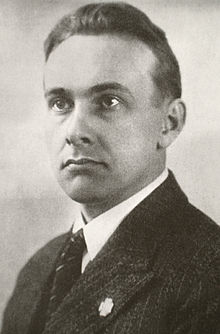Artur Sirk
Artur Sirk | |
|---|---|
 Artur Sirk in 1933 | |
| Born | September 25, 1900 |
| Died | August 2, 1937(aged 36) |
| Cause of death | Fall from a window |
| Resting place | HelsinkiHietaniemi cemetery |
| Nationality | Estonian |
| Citizenship | Russian,Estonian |
| Education | Tartu UniversityJusticecum laude1926 |
| Alma mater | Tartu University |
| Occupation | Lawyer |
| Known for | Politician, soldier |
| Political party | Vaps Movement |
| Spouse | Hilda Sirk (Arnover) |
| Children | Viivu Sirk |
Artur Sirk(25 September 1900 – 2 August 1937) was anEstonianpolitical and military figure. A veteran of the country's struggle for independence, Sirk later became a leading figure within theright-wingVaps Movementand an outspoken opponent of the government.
Early years
[edit]A native of ruralJärvamaa,Sirk came from a humble background, being a farmer's son.[1]As a student he was amongst the first to volunteer to fight against the mobilisingRed Armyin theEstonian War of Independence.[2]
Following the war Sirk was demobilised and went to theUniversity of Tartuto study law before in 1923 enlisting in theEstonian Armywhere he was allowed to complete his studies.[1]Leaving the army in 1926 he went to work in the legal firm of Theodor Rõuk, who had briefly served asEstonian Minister of the Interiorin 1924.[1]Sirk was soon involved in politics too, initially with the Settlers' Party, a vaguely rightist group led byIlmar Raamot,whom Sirk knew from both his school and army days.[3]
Vaps Movement
[edit]Sirk joinedEesti Demobiliseeritud Sõjaväelaste Liit(Estonian Demobilised Soldiers League) upon its formation in 1921 and its successor movement,Eesti Vabadussõjalaste Liit(Union of Participants in the Estonian War of Independence), being appointed deputy chairman of the latter group at its inaugural general meeting on 10 October 1926.[4]Both of these groups had little ambition beyond being ex-servicemen's associations however Sirk desired a more centralised structure and to this end he established theEesti Vabadussõjalaste Keskliit,orVaps Movementas it became known, in 1929. Whilst the chairman of the new group was GeneralErnst Põdderit was Sirk who drafted its statutes, including an enshrined duty of leadership of the country's youth for the movement, and he also secured a seat on the eight member executive chosen at the first Vaps national congress on 26 January 1930 inTallinn.[5]
Sirk's speech at their 1932 conference gave the impetus for a change in direction as he called for a party that could take advantage ofcitizen's initiativeto ensure the transfer toauthoritarianism.[6]Vaps adopted an increasingly paramilitary style that mirrored many of the characteristics of thefascistmovements growing elsewhere in Europe and Sirk, who was talented orator and charismatic demagogue, was soon recognised as the movement's driving force.[7]The group came close to power in 1933 before being banned byKonstantin Pätsthe following year.[6]The government had claimed thatAndres Larka,Sirk and other leading Vaps figures had been preparing to launch a coup although in this instance there was little evidence that the allegations were true.[8]Nonetheless, Sirk was one of a number of Vaps leaders arrested by the Päts regime but he escaped from prison and fled toFinland.[9]
Between 1934 and 1935 he directed Vaps activity from his Finnish base and even became involved in a conspiracy to overthrow the Estonian government with his allies in theLapua Movement.[10]Plans for an armed rebellion against Päts were put in place but these were discovered in December 1935 by the state security police with the main ringleaders arrested.[11]Sirk however was not amongst those arrested as he was able to escape again and this time settled inLuxembourg.[6]
Death
[edit]
Sirk died after a fall from a hotel window inEchternachin circumstances that have remained suspicious for some commentators to this day.[6]Estonian historians including Pusta[12]and Tomingas[13]have argued that the death was an act ofdefenestrationby agents of Päts, although local police in Luxembourg stated that it was a suicide.[6]Sirk's funeral was held inHelsinkion 9 October. The eulogy was delivered byElias Simojokiwhilst hundreds of members of Simojoki'sSinimustatyouth movement and theAcademic Karelia Societywere in attendance. August Jääger, an Estonian nationalist in attendance, blamed Sirk's death on the Estonian government, helping to begin the historical debate over the death.[14]
References
[edit]- ^abcAndres Kasekamp,The Radical Right in Interwar Estonia,London: Palgrave Macmillan, 2000, p. 26
- ^Kasekamp,The Radical Right in Interwar Estonia,p. 10
- ^Kasekamp,The Radical Right in Interwar Estonia,p. 55
- ^Kasekamp,The Radical Right in Interwar Estonia,p. 24
- ^Kasekamp,The Radical Right in Interwar Estonia,pp. 24–25
- ^abcdePhilip Rees,Biographical Dictionary of the Extreme Right Since 1890,p. 361
- ^David James Smith,The Baltic States: Estonia, Latvia and Lithuania,London: Routledge, 2002, p. 18
- ^Toivo Miljan,Historical Dictionary of Estonia,Lanham MD: Scarecrow Press, 2004, p. 305
- ^Smith,The Baltic States,p. 20
- ^Kasekamp,The Radical Right in Interwar Estonia,p. 2
- ^Smith,The Baltic States,pp. 20–21
- ^K. Pusta,Saadiku päevik,Geislingen, 1964, vol. 1
- ^W. Tomingas,Vaikiv ajastu Eestis,New York, 1961
- ^Kasekamp,The Radical Right in Interwar Estonia,p. 118
External links
[edit]- 1900 births
- 1937 suicides
- 1937 deaths
- People from Tapa Parish
- People from Kreis Jerwen
- Estonian Lutherans
- Members of the Vaps Movement
- 20th-century Estonian lawyers
- University of Tartu alumni
- Estonian expatriates in Luxembourg
- Estonian military personnel of the Estonian War of Independence
- Recipients of the Cross of Liberty (Estonia)
- Estonian politicians who died by suicide
- Burials at Hietaniemi Cemetery
